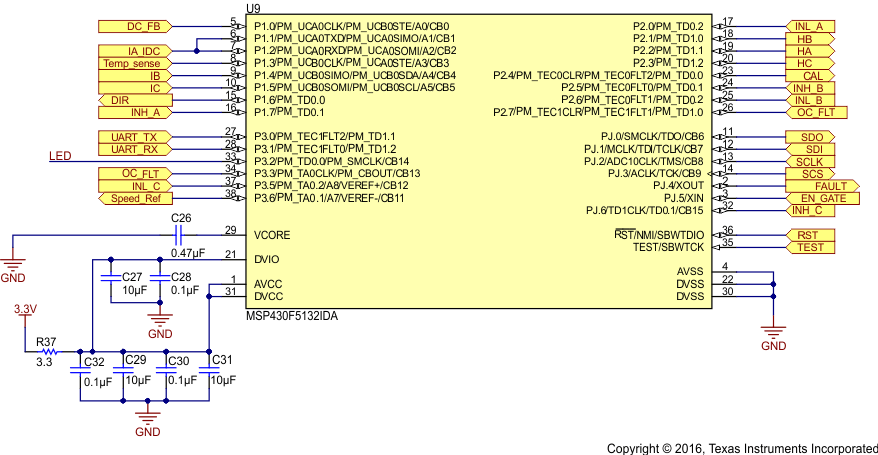TIDUCL0 January 2017
- 1 Description
- 2 Resources
- 3 Features
- 4 Applications
- 5 Design Images
- 6 System Overview
-
7 System Design Theory
- 7.1 Power Stage Design—Battery Power Input to the Board
- 7.2 Power Stage Design—Three-Phase Inverter
- 7.3 Power Stage Design—DRV8323 Gate Driver
- 7.4 Power Stage Design—18-V to 3.3-V DC-DC Converter
- 7.5 Power Stage Design —Microcontroller MSP430
- 7.6 Power Stage Design—Hall Sensor Interface
- 7.7 Temperature Sensing
- 7.8 Power Stage Design—External Interface Options and Indications
- 8 Getting Started Hardware and Software
- 9 Testing and Results
- 10Design Files
- 11Software Files
- 12Related Documentation
- 13Terminology
- 14About the Author
7.5 Power Stage Design —Microcontroller MSP430
Figure 8 shows the schematic for configuring the MSP430F5132 MCU. The resistor R37 is used to limit the dV/dt at the supply pin of the MSP430F5132. The TIDA-00774 reference design uses 10-μF decoupling capacitors. A 0.1-μF capacitor has been added to obtain the best performance at a high frequency.
The Timer D of the MCU is used for PWM generation. The TD0.1 instance of the timer and the corresponding pins are mapped to the high-side switch PWM. The TD0.2 instance of the timer and the corresponding pins are mapped to the low-side switch PWM. The TIDA-00774 reference design uses unipolar, trapezoidal BLDC control where the high-side switches switching at a high frequency. The low-side switches switch at the electrical frequency of the motor current, which is much lower and the same will switch at a high frequency (complimentary to high-side switch) during the freewheeling period to enable active freewheeling and hence low losses. All the feedback signal voltages including the DC bus voltage, current sense amplifier output, potentiometer voltage for speed control, and temperature sensor output are interfaced to the 10-bit successive approximation (SAR) ADC channels of the MCU. The current sense amplifier output is also connected to the comparator input.
 Figure 8. MSP430F5132 Schematic
Figure 8. MSP430F5132 Schematic